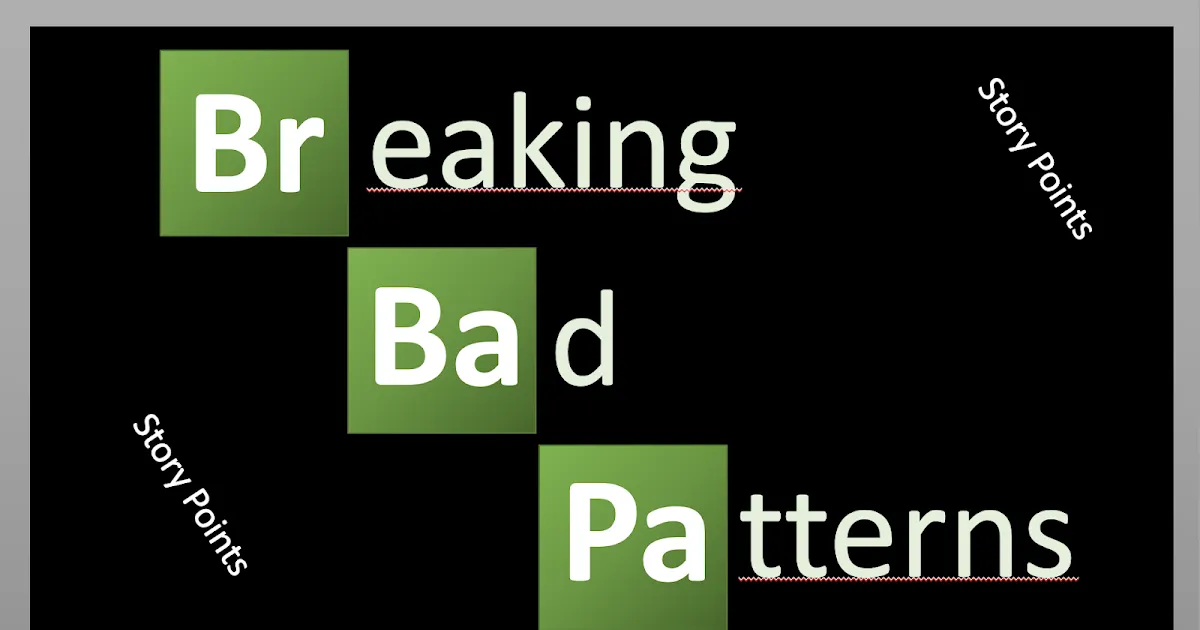Breaking Bad Story Point Anti-Patterns
Blog: Agile Adoption Roadmap
There is occasional controversy in the Agile coaching community on whether to apply Story Points on user stories. This often stems from the challenge where some think that story points are a direct replacement for estimation and an expectation of precision while others suggest that instead of story point sizing, we should focus on focusing on small pieces of work. In other words, when applying a practice (e.g., story points), a bad pattern is implemented which is opposed to the way practice is meant to be applied. This is known as an anti-pattern. Anti-patterns lead to results that are counterproductive to the intent of the practice and reduce their effectiveness. In other words, not good.
What is Story Point Sizing?
Before we go further, let’s take a moment to define what is a story point? A story point is a unit of measure describing the size, complexity, and risk to gauge the amount of work needed to complete a particular user story.
Story points are also a relative measure to a specific team. Every team creates their own story point sizing framework based on the type of work they do, the skills and experience of the team, and what they personally perceive to be a small, medium, or large amount of work. The team collaboratively determines the story points for each story based on its perceived size, complexity, and risk.
Story points are often correlated with small, medium, and large sized work. Some use the Fibonacci as it provides a numeric distribution that can be used to differentiate between sizes of work typically using 1, 2, 3, 5, 8, 13, 21. When using Fibonacci numbers, 1, 2, and 3 are aligned with small work, 5 and 8 are medium sized work, and 13 and 21 denote large pieces of work.
Velocity is a metric that can help a team understand their sustainable pace by identifying the amount of story points of work a team can complete in an iteration. In each case (e.g., story points and velocity), this is why you should not compare the story point velocity across different teams. Story points and velocity are very specifically a team measure and should not be tampered with by those outside of the team.
Anti-patterns of applying Story Points
The reason there is concern surrounding applying story points is the ways it gets applied. As mentioned, story points are a combination of size, complexity, and risk of that specific piece of work (aka., user story). This means they are not meant to be used as a predictor or for accuracy. Here are several anti-patterns of story points in the way they get applied:
- Unfit Translation anti-pattern - Some apply story point sizing as if it is nothing more than an estimate of hours and days (and weeks and months). There is often a direct translation of small, medium, and large to days.
- Pretend Certainty anti-pattern - There is often ascribed a sense of certainty when applying story point sizing where it gets used to predict when work will get done. At best, it can help with understanding progress, but you would never estimate “all” of the work up front anyway as priorities (and requirements) tend to shift so it would be a waste to do so.
- Pretend Precision anti-pattern – There is precision when using story points which isn’t appropriate. The numbers that story points represent are meant to be ball-park numbers as it is an amalgamation of size, complexity, and risk.
- Contrived Comparison anti-pattern – Some organizations attempt to compare story points and velocity across teams even though they are relative to the team’s composition and the type of work they focus on. This is inappropriate and decreases the integrity of story points and velocity.
- Effort Tampering anti-pattern – This occurs when someone outside of the team (usually management) attempts to influence the amount a work a team does by insisting on improvement. This impacts the integrity of the story point sizing framework and the velocity data as those are meant specifically for that team to have meaning.
- Inflation anti-pattern – This can be the result of when someone outside of the team applies the Effort Tampering anti-pattern by attempts to make the team “work harder”. The result may be that the team inflates their numbers to ‘satisfy’ the influencer and effectively impact the integrity of the story point sizing framework.
- Productivity anti-pattern – This is when story points and velocity get conflated as a productivity measure by those outside of the team. They are not productivity measures and will warp the intent of both story points and velocity.
Mending Anti-Patterns
The best way to eliminate or reduce anti-patterns, is to first understand what anti-patterns look like (see Anti-Pattern section above and search of other information on anti-patterns). Then do detective work to uncover what anti-patterns may exist. Follow this with determining an action to remove or eliminate them. You can do this through a theme-based retrospective where the focus is on identifying anti-patterns.
Anti-patterns within an organization are more commonplace than you think. They are often due to a lack of clarity of what are story points, how they should be applied, and a lack of awareness that they are specifically a team-based measure. There may also be management or team member influence to use the practice or technique incorrectly. If too many of these anti-patterns exist, then the value of using story points as a team measure and as an instructive tool to help team gauge what is considered small diminishes.
